Looking at the teams that were promoted from the Eerste Divisie last season into the Eredivisie, the top tier of Dutch football, names like PEC Zwolle and Heracles are familiar, as they are two teams who recently competed in the Dutch top flight.
However, many might not have heard of the third team that was promoted: Almere City. The club was founded under a different name in 2001 before, in 2010, being renamed Almere City. This is the first time the club have been in the top flight, with them under the management of former Sparta Rotterdam and SCR Altach manager Alex Pastoor.
After a third-placed finish and victory over Emmen in the promotion playoffs last season, they are finally in the top flight. This tactical analysis will look at Pastoor’s tactics and what to expect from the Dutch side this season. We will also analyse whether or not they have the pieces to do well this season and stay in the top flight next season.
Pressing phase and defending from the front
When watching Almere City under Alex Pastoor tactics, one of the more common tactical principles you will see is the frequent use of counterpressing. Last season in the Eerste Divisie, the Dutch side were one of the most successful and aggressive sides when it came to counterpressing, as the data viz graphic below illustrates.
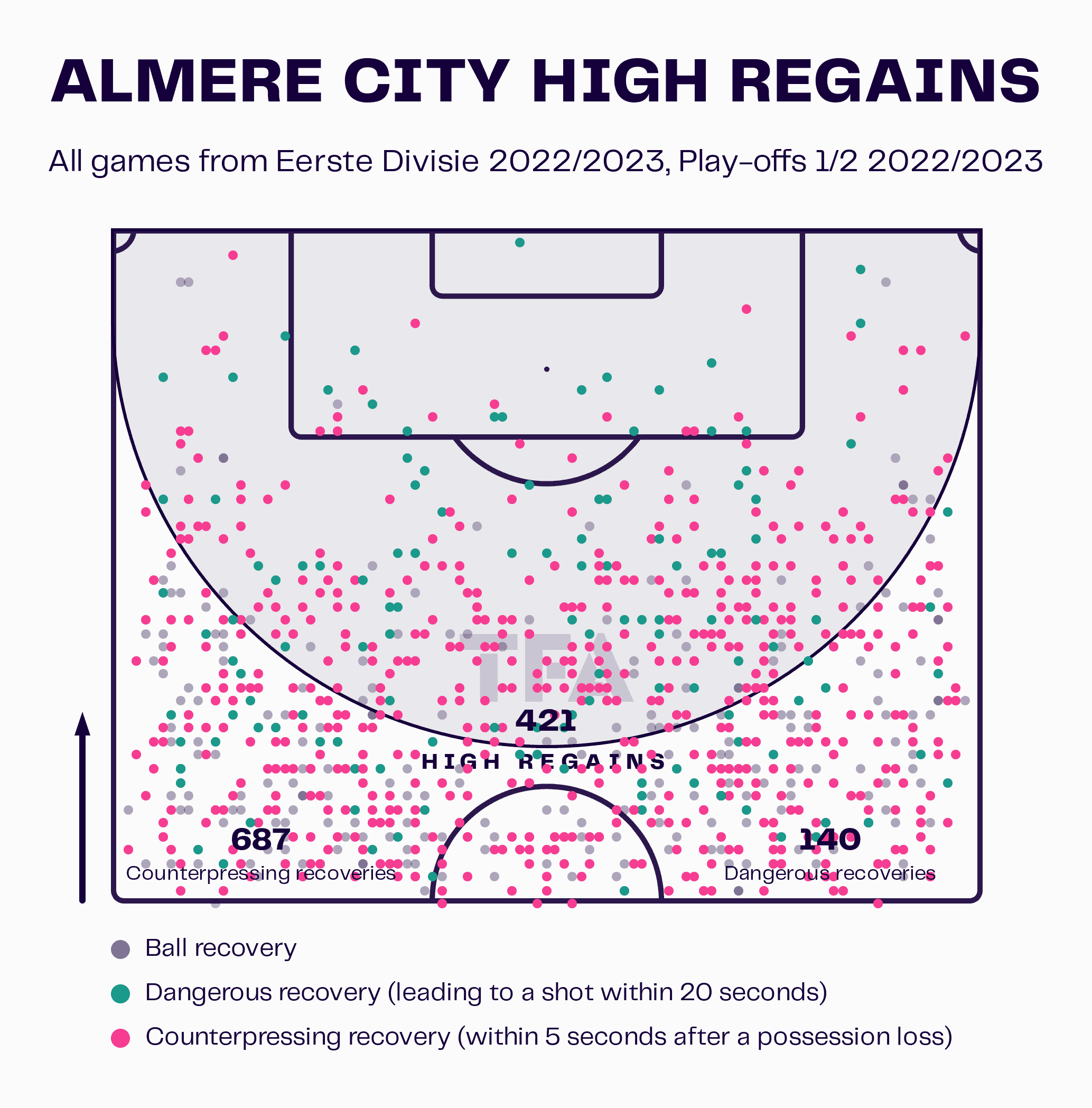
As we can see from the graphic, Almere City had 687 counterpressing recoveries last season, with 140 of those being dangerous. These totals equate to one of the highest amounts in the Eerste Divisie from the 2022/23 season and one of the reasons why the Dutch side are now in the Eredivisie for the first time in their history. This is also to go along with 421 total high regains last season, showing that, in general, they look to defend from the front often when possession is turned over in advanced areas.
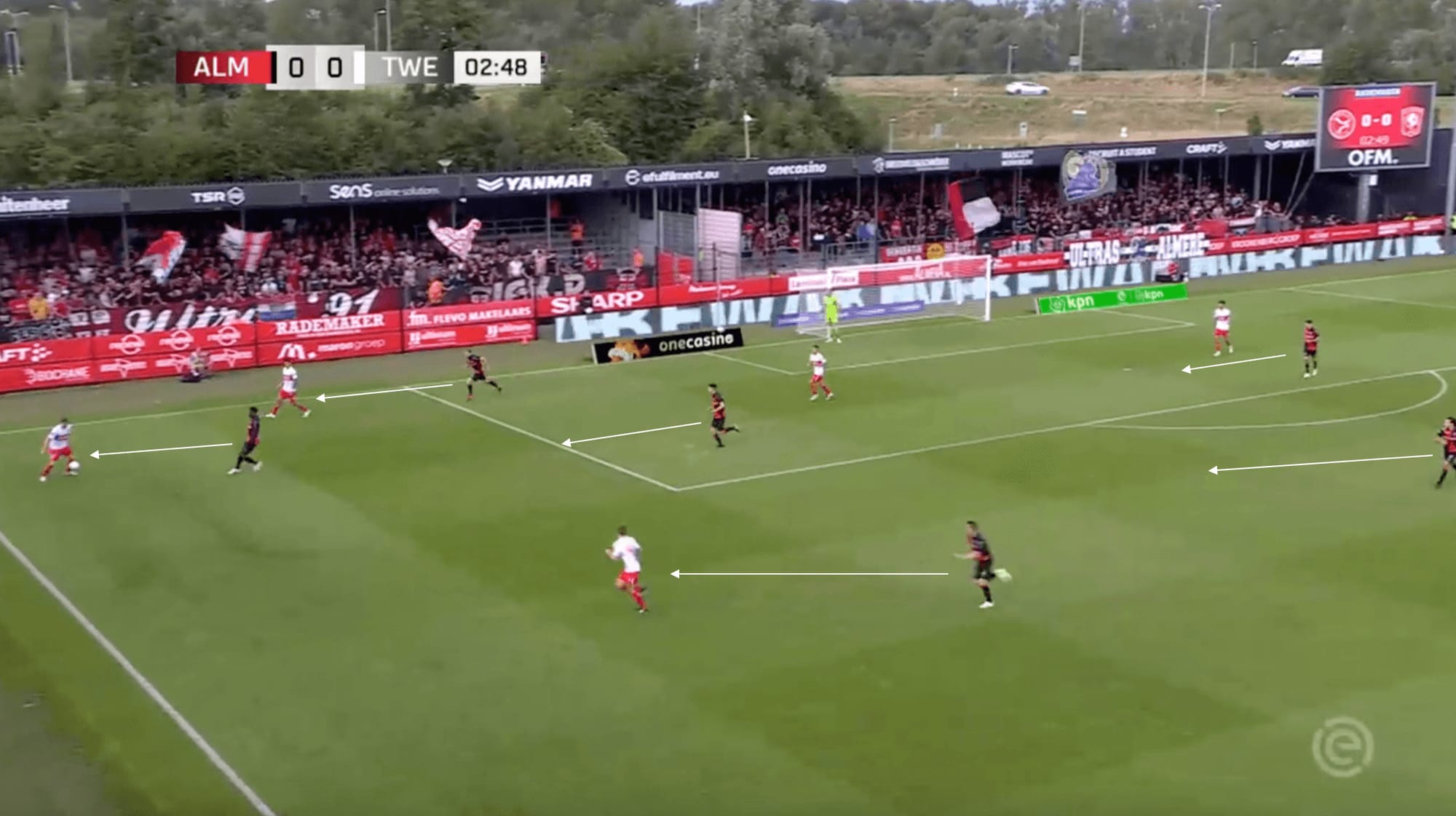
The image above shows an excellent example of the pressing style that Almere City look to utilise, with the phase of play above showing how they shift quickly to attempt to lock the ball to one side of the field.
Twente looked to build out from the back early in the match, with the goalkeeper playing the ball to the right-sided central defender. The ball is then quickly played out wide to the full-back on the touchline, with this movement activating the Almere City press to lock it to one side.
As we can see from the image, the Almere City attackers and midfielders all quickly shift and put pressure on this near side, with the goal to lock the ball to this side and force either a turnover or long ball to their backline where they can regain possession.
They also look to man mark in these pressing phases, which is a high-risk style but can pay off with a high reward if the ball is turned over in an advanced area. The four closest Almere City players all crash into the space just outside the penalty area, though they are unsuccessful in keeping the ball locked to this side.
Twente can continue building and switch the play to the opposite flank. However, after about another few passes, Almere City can regain possession and start a transitional attacking moment. Though in this example, they were not able to keep it pinned into the near side, it still illustrates what Pastoor looks for his side to do in these pressing phases of play.
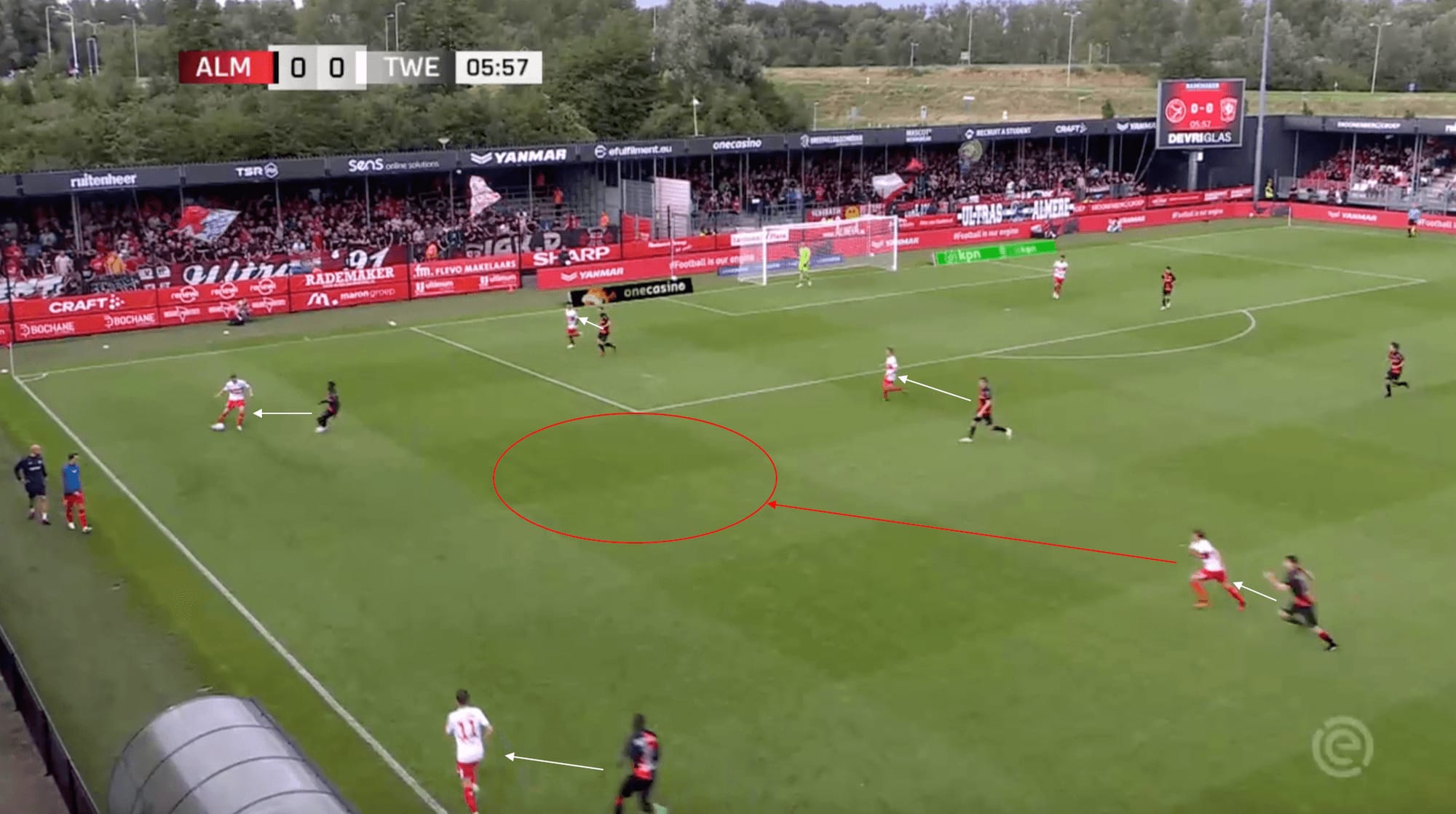
The image above shows another example of this aggressive pressing style from Almere City in the same match against Twente. In this phase of play above, we can see the man-marking press that the Dutch side are using, with all the potential short passing options for Twente marked tightly by a player wearing black and red.
With the full-back being put under relatively immediate pressure after gaining possession from the centre-back, he plays a ball on the ground into the pocket of space that one of the Twente midfielders is dropping into, looking to use this potential outlet pass to escape the pressure.
However, this is precisely what Alex Pastoor’s side wanted to occur, with all of the nearby pressers crashing into this area to swarm the player as he receives possession immediately.
As a result of this crashing and pressing with numbers, Almere City are able to win possession back in an advanced area. Due to the numbers they commit to this press, they can hit Twente on a dangerous attacking transition once they win possession back.
They can have seven attacking players in the general vicinity once possession is turned over, with all of them looking to catch the opposition defence on the break quickly. It does not occur in this phase, but it highlights the danger they will be able to pose against sides in the Eredivisie this campaign.
Attacking phase
Regarding the attacking phase, Almere City are a side that looks to play balls into the wide channels, with Pastoor looking to use the pace of his wingers to run onto these balls in behind and send dangerous crosses into the box.
The Dutch side are different from one that will look to dominate possession for a match, so this style of utilising the wide areas is crucial to how they look to create chances going forward.
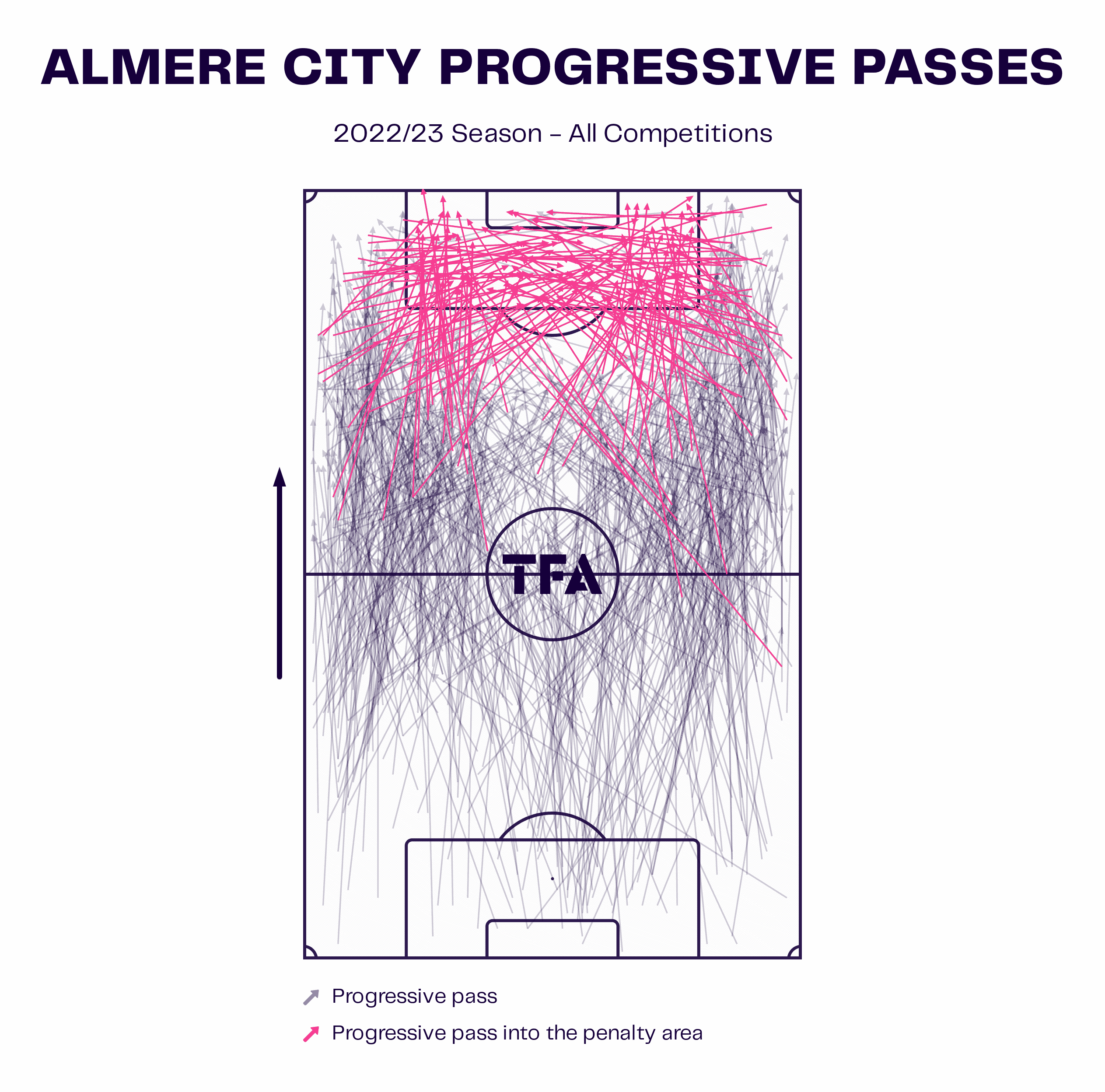
The data viz graphic above shows the progressive passes from Almere City last season in all competitions, with the passes in pink being into the penalty area. As the graphic shows, most of the progressive passes into the penalty area occurred from the wide areas, with these being the result of balls being played into these wide channels to the wingers.
This attacking style is why the wingers in Almere City’s 4-3-3 formation are crucial to attacking success, with their two starting wingers last campaign contributing to 11 assists combined, going along with eight goals.
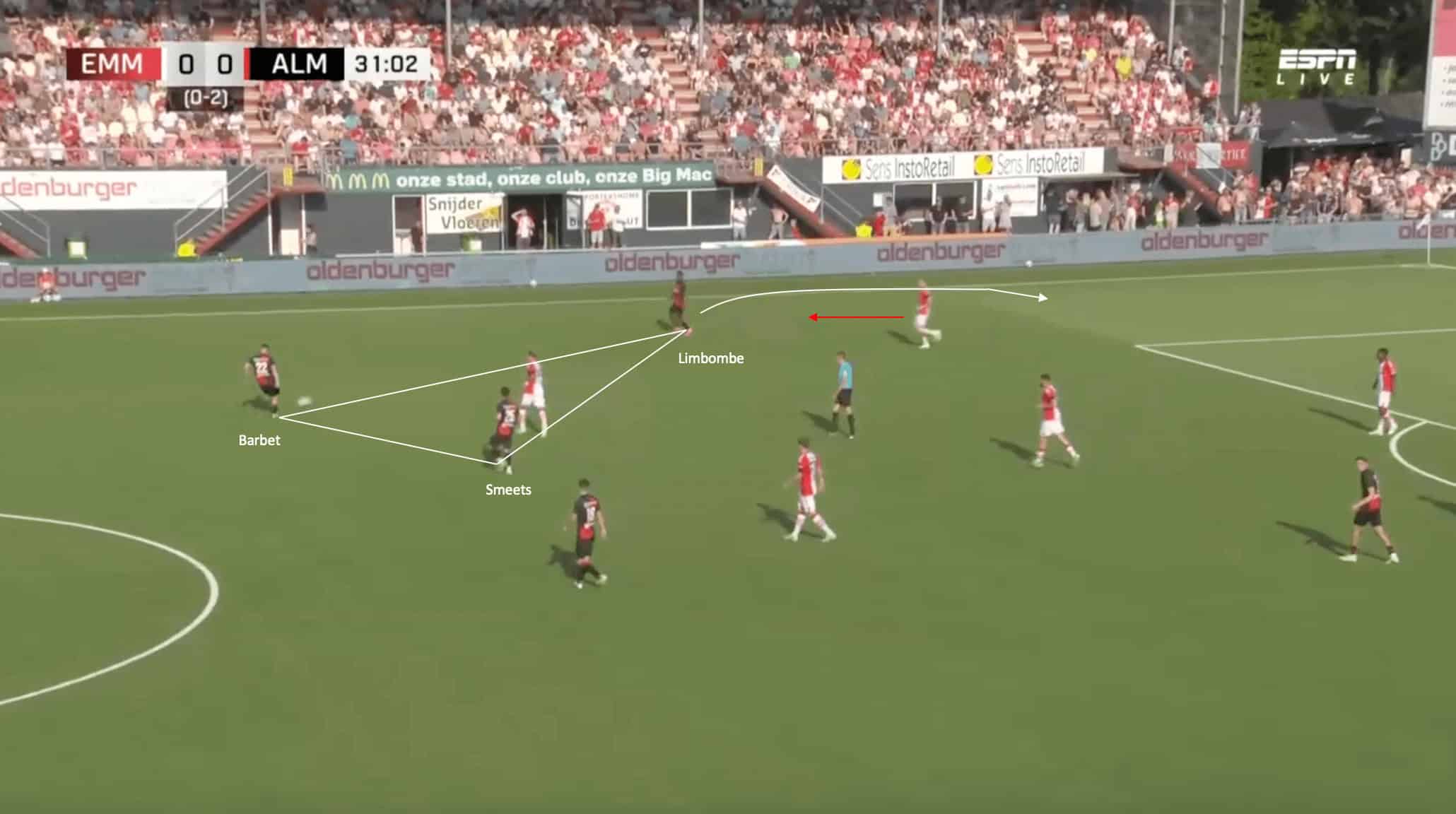
The image above shows an example of using wide areas to create chances in the central ones. In this phase of play above from last season’s Eerste Divisie playoff final against FC Emmen, Almere City are in possession, with the full-back Barbet operating in a more narrow position.
Due to his narrowness and tucking inside into a more central area, an overload is created with both the central midfielder, who has shifted over, and the left winger Anthony Limbombe. With Limbombe dropping into a slightly deeper position, it attracts the attention of the Emmen full-back, who vacates his zone to man-mark Limbombe.
As a result, the full-back gets a bit too tight to the winger, allowing him to turn after receiving possession and drive past him and into the vacant space. The resulting cross is sent into the area just in front of the six-yard box, with a dangerous ball and chance resulting from this overload and movement out wide from Limbombe.
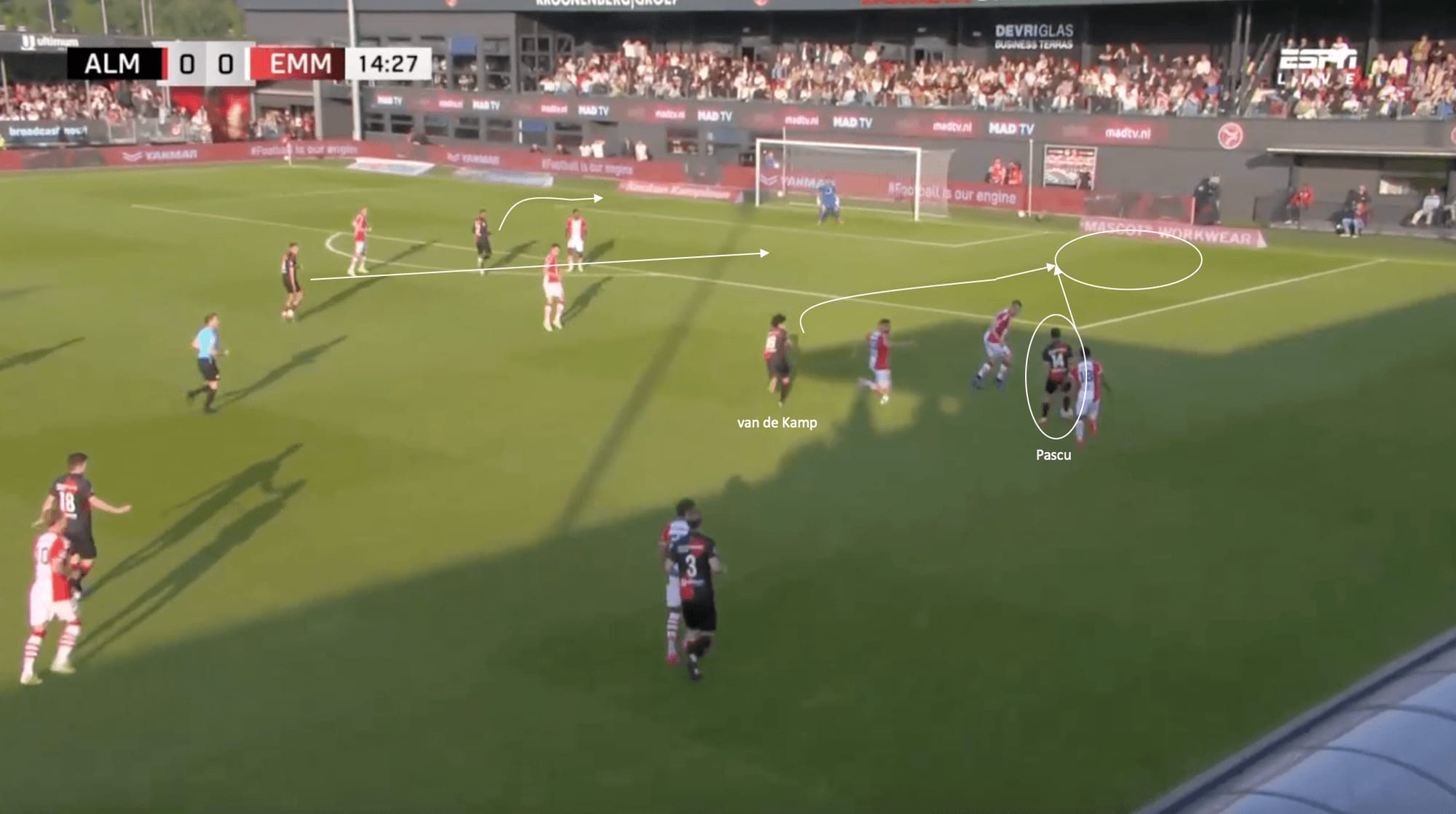
The image above shows another example of Almere City looking to prioritise attacking the wide channels when they progress the ball into the final third of the pitch.
In this phase of play above from the first leg of the Eerste Divisie playoff final last season against Emmen, the ball is in possession of the winger on this near side.
Pascu can attract the attention of the three Emmen players closest to him, allowing the full-back to make an underlapping run into the space behind the backline.
The ensuing pass by the winger is played into that space beyond, allowing van de Kamp the ability to run onto the pass. In the central area, the two advanced Almere City players are able to layer their runs well, allowing them both to be options as van de Kamp plays a dangerous ball across the box.
As this section has shown, Almere City succeeded last season in the second division of Dutch football by using wide channels when attacking. This has been demonstrated in these examples and the statistics, with the wide players being heavily impactful in goal contributions last season.
If they succeed in cementing their place in the Eredivisie for a second consecutive season, the wingers will have to have a similar impact going forward this season as well.
Defensive phase
Regarding the defensive phase of play for Almere City, if they cannot win back possession in the advanced areas with their aggressive pressing, they will look to drop off and defend in a more narrow and compact shape.
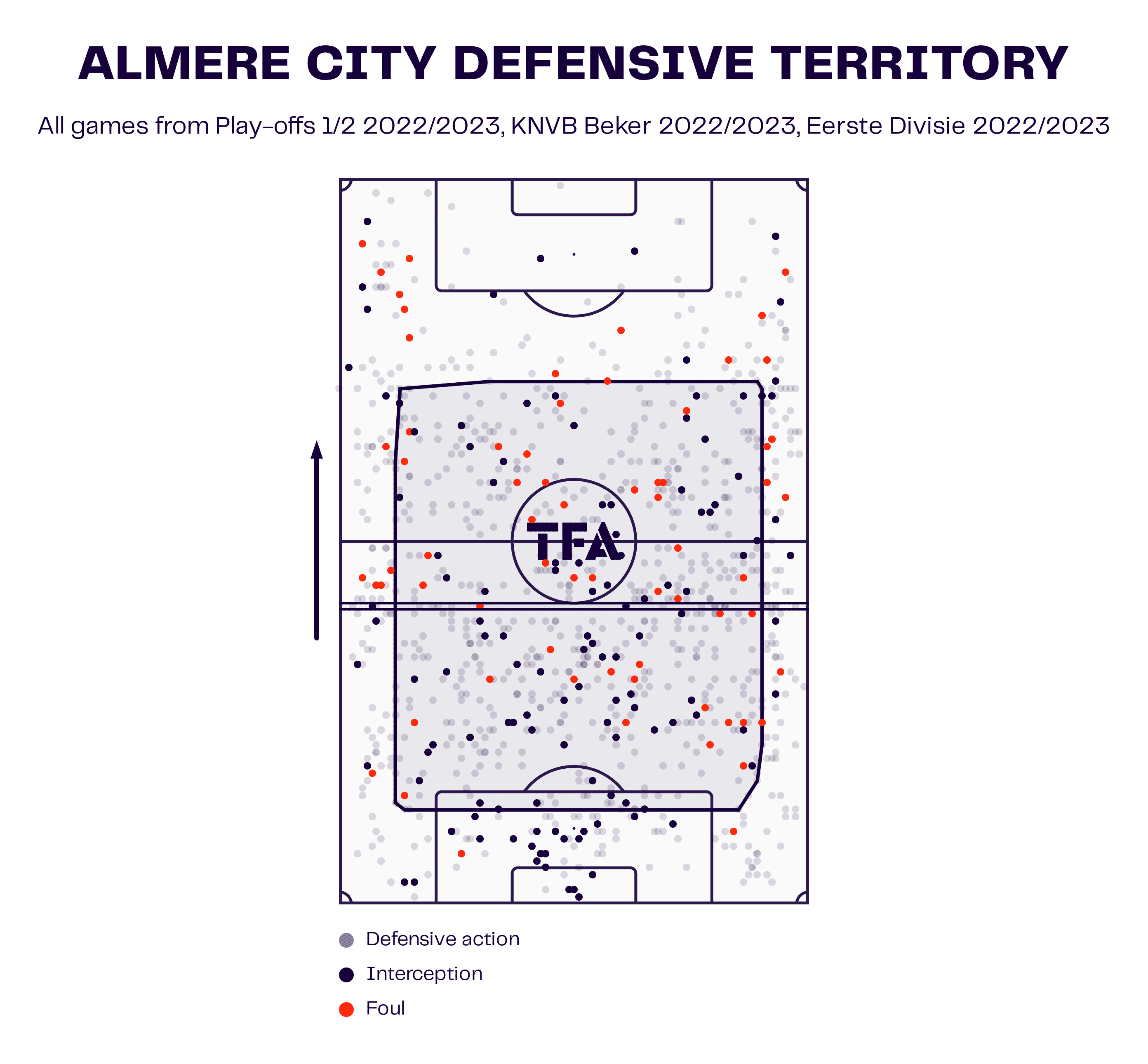
The data viz graphic above shows the defensive territory Almere City covered last season in the Eerste Divisie. As we can see, most of their defensive actions and interceptions occurred just outside their defensive final third, which highlights the tendency for them to drop off and look to defend compactly at times.
This is relatively unsurprising, as Almere City were one of the lesser quality teams in the Dutch second division compared to the sides around them that have been in the Eredivisie recently and were fighting for promotion.
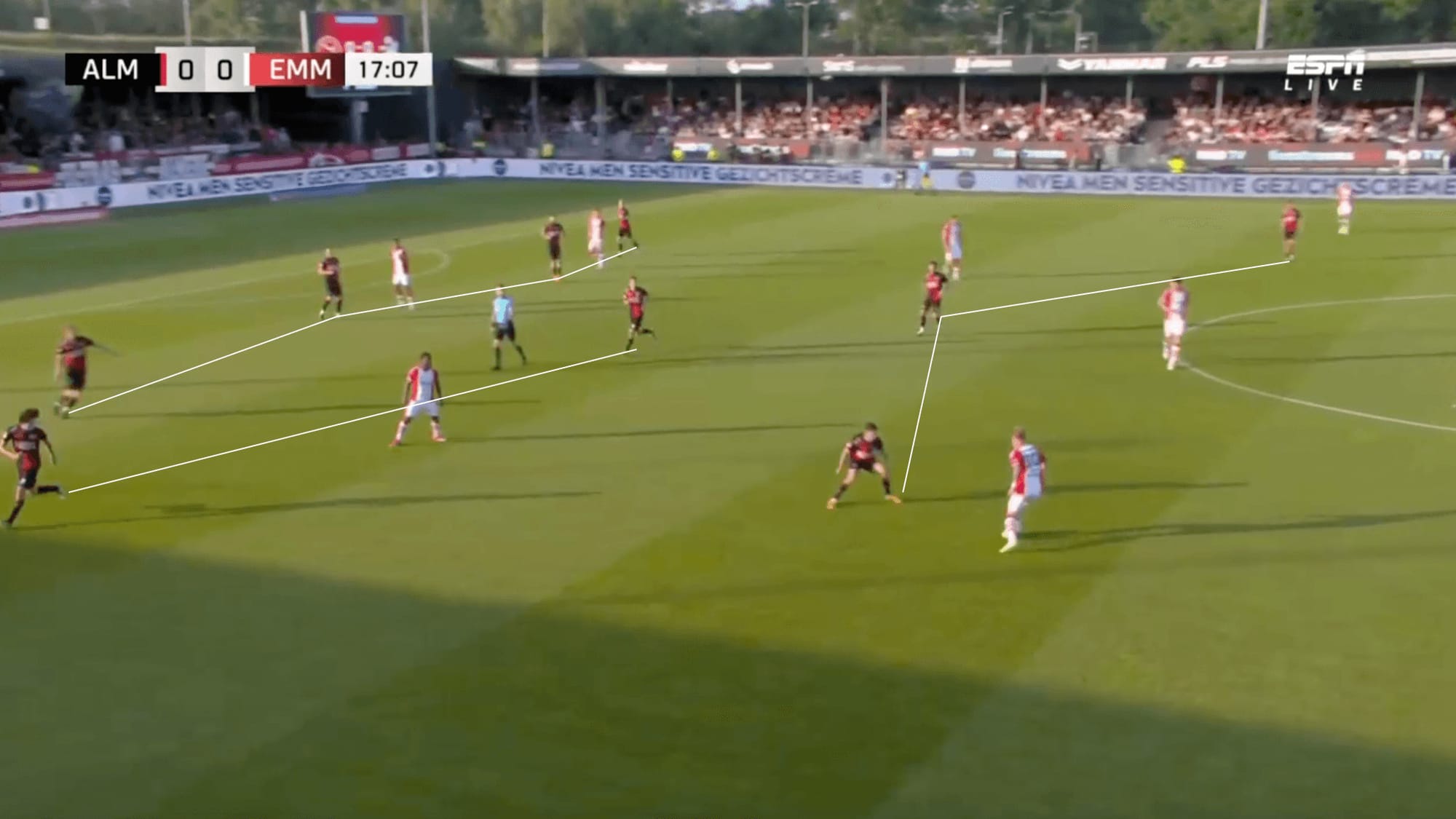
The image above shows an example of the defensive shape that Almere City will sometimes revert to when forced to drop back into more of a defensive shell. While Alex Pastoor style of play prefers to use a 4-3-3 formation in defensive phases, this shape will transition into a 4-2-3-1, as the image above shows.
Switching to this formation offers his side more balance defensively in the central areas, as the five midfielders are able to overload this area and clog it, forcing opposition sides to play out into the wide channels if they want to progress into Almere City’s final third area.
This is what the Dutch side wants opposition sides to do, as it allows them to get compact and narrow and pushes them away from the goal and into the less dangerous areas.
However, in their first game in the Eredivisie against Twente this season, Pastoor opted for a slightly different defensive shape, which will likely become commonplace for them this campaign.
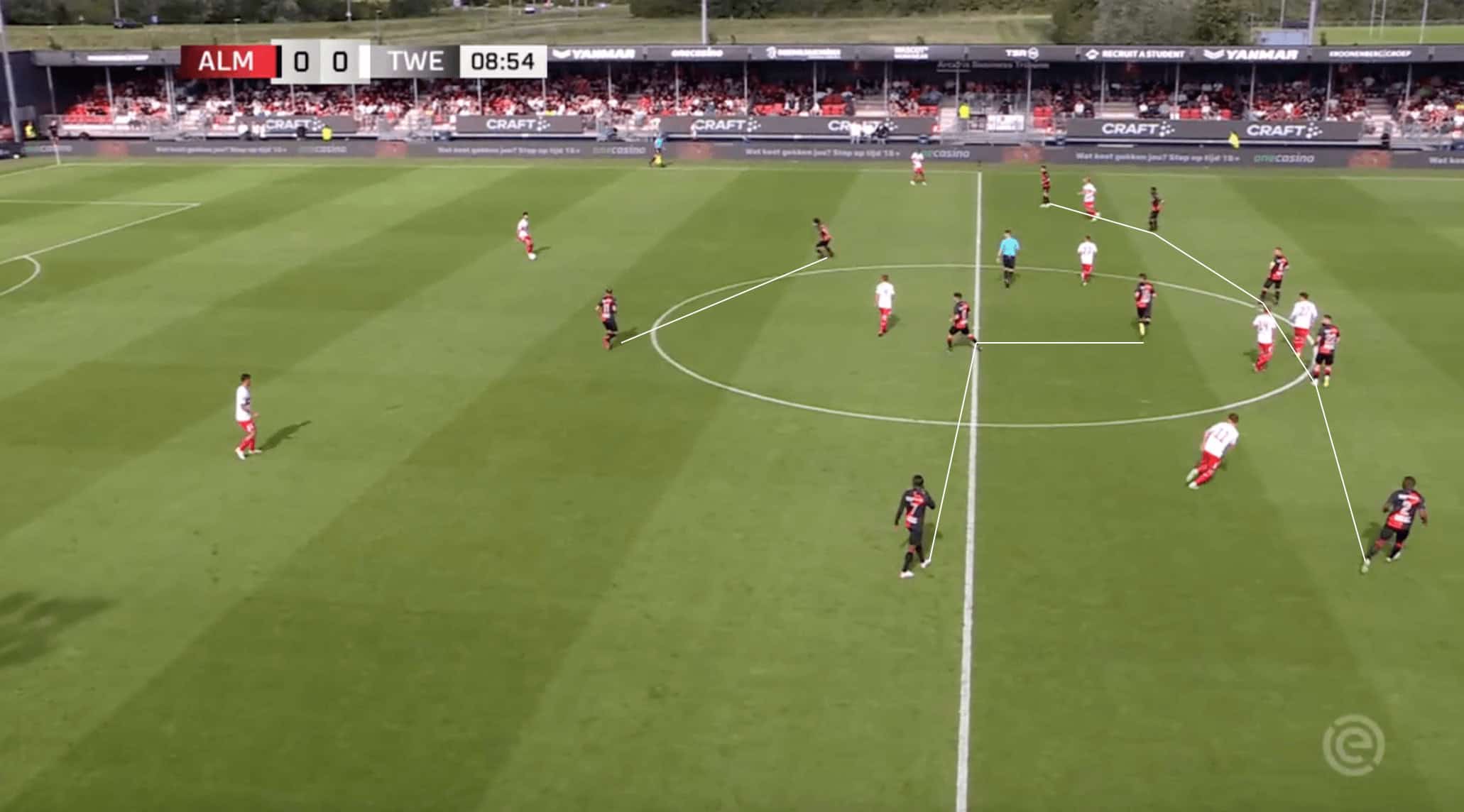
The image above shows a more defensive-minded 5-3-2 shape when they are out of possession, allowing them to have even more defensive security against stronger opposition sides, something they will experience more in this division.
From a defensive standpoint, Almere City have a massive task on their hands in almost all the Eredivisie games they will play in this campaign. If they are to survive, their defensive solidity will have to play a large part in achieving this goal.
Conclusion
As this analysis has shown, Alex Pastoors has done a tremendous job leading Almere City into the Eredivisie for the first time in the club’s young history.
While it will no doubt be a challenging task on their hands, it is one that the Dutch side will relish as they bid to make sure they will not end up going straight back down to the Eerste Divisie next season.





Comments